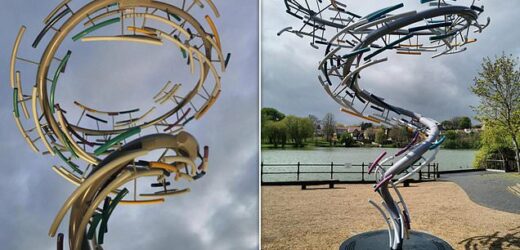‘It’s looks like a washing line!’ Fury over EU funded sculpture installed at Norfolk market town’s beauty spot as locals say it blocks picturesque views and is a magnet for vandals and pigeons
- The ‘Flock’ artwork was installed at a beauty spot nearby a mere in Diss, Norfolk
- Locals have slammed it as an ‘eyesore’ which blocks views and attracts pigeons
Residents of a picturesque lakeside market town have been left divided over an EU-funded sculpture described as looking like a ‘washing line’ or ‘children’s play equipment’.
The artwork, called Flock, was installed next to the historic town sign at a beauty spot which overlooks the Mere – a deep, natural lake in Diss, Norfolk.
But locals say it is an eyesore which blocks the view and will be a magnet for vandals, drunks and pigeons.
Steve Harold complained: ‘The piece of art is a Marmite type of thing – you either like it or dislike it.
‘It’s not my cup of tea but my main gripe is where it was located – smack bang in the middle of the view over the main focal point of the town.’
The artwork, called Flock, was installed next to the historic town sign at a beauty spot which overlooks the Mere – a deep, natural lake in Diss, Norfolk
Locals say it is an eyesore which blocks the view and will be a magnet for vandals, drunks and pigeons
Mike Bardwell said: ‘It is in totally the wrong place and has ruined one of the most photographed places in the town.’
A further criticism came from Denise Elyot who wrote: ‘It is awful, pointless and will certainly attract the wrong attention from kids, people going home from the pubs, and pigeons.’
There was some cautious support, however, with photographer Simon Wilkins saying: ‘Though I can sympathise with the view that the money could be better spent, it’s worth remembering that its purpose is to encourage tourism to the area.’
Flock was designed by toyStudio, a London-based collective founded in 2016 which combines art and architecture.
It was inspired by ‘the flocking of flights of birds, schools of fish and the swarms of eels which are synonymous with the Mere and the nearby River Waveney’.
As well as mimicking the behaviour of wildlife, the piece ‘represents the movements of Diss’s own residents’ with the silver tubes imitating ‘the individual directions we take within a community and how we move forward together as one’.
The local community was invited to share personal stories, with messages imprinted on the artwork to provide ‘a moment for quiet contemplation and reflection’.
It is one of four large-scale pieces built as part of a 250-mile sculpture route through the county, known as the Norfolk Way Art trail.
Intended to generate tourism during the October to March off-season, the project was funded by a £525,000 (600,000 Euro) European Union grant which was allocated before Brexit.
The others include Plain Sight, a roofed structure at King’s Lynn’s Boal Quay, designed to ‘take people away from their smartphones and laptops and re-engage with their senses and the world around them’.
It was inspired by ‘the flocking of flights of birds, schools of fish and the swarms of eels which are synonymous with the Mere and the nearby River Waveney’
The Iron Reef, at Reedham Ferry Inn, is a curved, metallic amphibious viewing platform with a bioluminescent walkway which ‘invites visitors to contemplate the seasons’ changes on the River Yare’.
On North Walsham and Dilham Canal is Honing Passage – an ‘immersive sculpture made of two large panels of reinforced glass… [with] colour-treated two-way mirrors’.
The offset panels create an ‘ever-shifting showcase of colour, light and nature’ to ‘express a sense of movement like the railway carriages that used to travel on the nearby tracks’.
The council was contacted for a comment on Monday.
Speaking previously, Margaret Dewsbury, the cabinet member for communities and partnerships, said: ‘The council is delighted to have worked with local communities and stakeholders to commission innovative artworks that residents can be proud of and will attract new visitors to our county.’
Diss takes its name from the Mere, with Dic or Disce being the Saxon word for ‘ditch of standing water’.
Local rumours have attributed the natural feature to volcanic activity and a meteor strike – both unfounded.
It is more likely to have been created by the collapse of chalk bedrock at the end of the last Ice Age.
During the harsh winters of the 19th century, carnivals would take place on the frozen lake.
A cricket match was played there in 1827, five years before the death of local citizen Thomas Lord, who founded Lord’s Cricket Ground.
It was once polluted by hatters and dyers who dumped their mercury-rich waste into the water, as well as local sewage.
Improvements to the water quality means it is now home to thousands of fish.
In 2020, a huge, non-native catfish that weighed 122lb was caught and removed by an angler, causing fury among locals.
But the Environment Agency said the fish, which had been ‘dropped in illegally’ ten years earlier, didn’t belong there.
In 2020, a huge, non-native catfish that weighed 122lb was caught and removed by an angler, causing fury among locals
Source: Read Full Article






